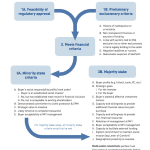Two Trends and a Caveat: The Three Factors That Will Define Impact Investing’s Future
In recent years, impact investing has come of age. In 2017, not only was more capital committed to impact investment strategies (17 percent more in 2017 versus 2016), but there was also significantly more buzz and excitement around the topic.
The sector’s positive momentum gives cause for optimism, and while there are a number of moving parts to the evolution of impact investing, two stand out clearly.
Technology = Scale (and Investor Interest)
The first is technological innovation. Technology plays a fundamental role in enabling businesses to solve age-old problems with new, innovative solutions. It allows new initiatives to be deployed at scale, as it is often cost-effective and far-reaching – a particularly important point when trying to reach communities with limited access to key services like energy, financial services and health care. Access to these services is essential for empowerment and well-being, so affordability is crucial – and technological innovation is the key to making this possible.
At Bamboo Capital Partners, we have seen this first hand with a number of our portfolio companies, such as BBOXX, which has already improved the lives of 500,000 people by providing clean, off-grid solar energy to households in over 35 countries. Across the world, there are over 1.1 billion people with no access to the energy grid and a further 2 billion people with unreliable access to it. So over 3 billion people on the planet lack reliable, centralized access to electricity, compromising not only their quality of life, but also their productivity and ability to generate an income.
BBOXX is using technology to tackle this problem, via its SMART Solar platform, which leverages machine-learning, customer experience optimization and a ground-breaking financing structure to deliver off-grid solar energy to rural Africa. This technology enables remote monitoring and data gathering on the systems BBOXX installs, proactive troubleshooting, efficient salesforce management and pay-as-you-go consumer finance. With over 100,000 systems deployed so far, the cumulative result is that clean, renewable, off-grid energy is supplied to those who previously did not have reliable access to the grid.
BBOXX is just one example of the impact technology can have and just one of several tech-driven companies in our portfolio. These sorts of companies will attract growing interest from impact investors, as existing technologies mature and new ones emerge.
New Entrants, New Impact
The second trend we’re witnessing in the impact investing sector is an increase in the number of new entrants. In a sign that the industry is becoming more mainstream, new entrants are coming from development finance institutions, high net worth individuals and corporations – all looking to make investments that deliver a financial and social impact.
Increasingly, corporates are realising that they can access new customers and markets through impact investing, and that financial and social returns are not mutually exclusive. For just one much-discussed sign of this momentum, take the recent statement by BlackRock’s Chairman and CEO Larry Fink in his annual letter to CEOs, when he said: “…every company must not only deliver financial performance, but also show how it makes a positive contribution to society.” This kind of commitment from the corporate world is a positive sign for the sector. New players in impact investing will benefit everyone across the value chain, from investors to end users, who focus on underserved populations to have impact at scale.
In addition to corporates, large traditional donor organisations are also starting to question whether traditional grant-making is the most effective method of generating impact at scale. Similarly, it is likely that a greater number of NGOs will join the impact investing movement.
Great Expectations = Greater Demands
While these developments provide great cause for optimism, it comes with a small caveat. As many large private equity firms have announced substantial pools of capital for impact investment – often with great fanfare – there are now big expectations. There is no getting away from the fact that investee firms must now deliver on their promise to generate both financial and social returns.
Furthermore, new entrants to the sector should be cautioned – impact investing requires strong skills and know-how. No stage of the equity investment should be overlooked – from proper valuation to competent risk management and timely, responsible exits. This requires professional skills, even more so when you’re dealing with companies in emerging markets that are targeting remote, under-served populations. With some scepticism still aimed at the impact investing sector, the success of recent years must not be undermined by a lack of tangible output in the future. As always, actions speak louder than words – investments with proven financial and social impact will reaffirm that the impact investing model works.
But regardless of elevated expectations or any risk of failure, the outlook for the sector is positive and clear. With a combination of technology and new entrants poised to propel impact investing through its next stage of development, the team at Bamboo look forward to innovating further in order to deliver both financial and social impact at scale. Though we’ve been in the sector for many years, we have never experienced a more exciting time.
Jean-Philippe de Schrevel is the founder and managing partner at Bamboo Capital Partners.
Top photo: Bamboo Finance investee BBOXX Staff in rural Rwanda (Photo credit: Power Africa)
- Categories
- Investing, Technology



